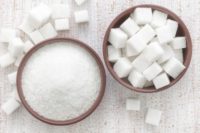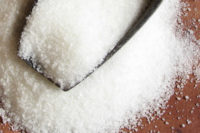Sweeter by the Dozen
By Kathie Canning
Developers of baked goods and snack foods can select from a growing range of sweetener options to create a wide variety of innovative new products.
Face it — some foods just don’t score well on the consumer craving scale. A serving of liver and onions, for example, is not a wildly popular way to finish off a great meal. And few of us keep a stash of Brussel sprouts in the desk drawer to enjoy with our afternoon coffee or tea.
On the other hand, the mere mention of fudge brownies or strawberry cheesecake is sure to make many of us swoon. Blame it on the sweetness factor — the delightfully pleasant taste that has tempted many a taste bud throughout mankind’s history.
Bakery and snack food product developers now can choose from a multitude of ingredients to sweeten cookies, cakes, bars and more, including natural sweeteners, derivatives and “artificial” alternatives. Even the traditional basic sweetener known as sugar — beet or cane-derived sucrose — now can be found in numerous forms.
Domino Specialty Ingredients offers an array of unique cane-sugar-based sweetening, flavor-carrying and other essential technologies, from free-flowing Brownulated sugar that lends a natural brown sugar flavor to cake and cookies mixes to FreshVert invert sugar that gives humectant and texturing properties to cookies, cakes and icings.
In fact, the Baltimore-based company says it created each of its products to perform a specific job “particularly well.” Moreover, Domino announced in 2006 that it had combined its cane sugar-based ingredient resources and expertise with those of West Palm Beach, Fla.-based Florida Crystals Corp. and C&H Sugar Co. of Crockett, Calif.
Likewise, the SunOpta Ingredients Group of Bedford, Mass., provides a range of natural dried honey and dried molasses products for bakery and snack food applications. These drum-dried and spray-dried products are easier to handle than liquids and can be formulated into dry seasoning blends or bakery mixes, notes Cathy Peterson, assistant vice president of applications for the group.
“The sweetener level ranges from 33% to 70% of the total solids,” she says. “We also offer soy-free and wheat-free versions for customers who need to avoid these two common allergens.”
The group has starting formulations available for various bakery products, Peterson notes. It also works with customers to develop targeted formulations. Although the starch used as a carrier with drum-dried sweeteners binds water, requiring a water adjustment, companies almost always can achieve the desired flavor intensity without “unacceptable” water addition rates, she adds.
Natural and organic freeze-dried powders are yet another natural sweetener option. Here, the Natural Products Division of Teterboro, N.J.-based Mastertaste, Inc. offers a line of all-natural and organic honey, maple syrup and molasses solids powders.
Designed to reduce production challenges associated with thick syrups and liquids, the free-flowing powders feature high concentrations of sweetener solids, Mastertaste reports. They are particularly suitable for dry mix applications and topical seasonings and coatings.
One highly publicized — and oft-criticized — spin on traditional sugar is high-fructose corn syrup (HFCS). Made from corn, HFCS is nearly identical in composition to table sugar (sucrose), according to the Corn Refiners Association. Delivered in liquid form, it is composed of either 42% fructose (HFCS-42) or 55% fructose (HFCS-55), with the remaining sugars being primarily glucose and some higher sugars.
Introduced commercially approximately 30 years ago as an affordable bulk sweetener, HFCS quickly has become the most widely used sweetener in the food processing industry. But some press reports also have blamed the ingredient and the “unique” way the human body metabolizes it for the rise in the nation’s obesity rate.
John White, president of Argenta, Ill.-based White Technical Research, and John Foreyt, professor of medicine at Baylor College of Medicine in Houston, disagree. In their article titled “High Fructose Corn Syrup and Sucrose — Similarities & Differences,” White and Foreyt contend, “Once absorbed into the bloodstream, the original source of the glucose and fructose — whether from sucrose, HFCS, honey or fruits — is indistinguishable.”
What White and Foreyt do have to say about HFCS is decidedly positive. The sweetener not only remains stable under acidic pH conditions and elevated temperatures, but also promotes superior browning in baked goods. Moreover, HFCS inhibits microbial spoilage by reducing water activity. Unlike sucrose, it does not crystallize, allowing bakers to create softer, moister cookies and more.
Sugar Stand-ins
Sometimes a “natural” sweetener just won’t do. Health concerns such dental caries, diabetes and obesity have combined to make alternatives to natural sweeteners big business. Although some alternatives such as aspartame cannot withstand the high temperatures associated with baking and snack applications, others serve as excellent sugar stand-ins.
For instance, polyols, also known as sugar alcohols, recently have branched out from confectionary applications into the bakery arena, thanks to biotechnology and processing advances. Divided into three main groups — monomers (erythritol, mannitol, sorbitol, xylitol), dimers (isomalt, lactitol, maltitol) and polymeric mixtures (hydrogenated starch hydrolysates, maltitol syrups) — polyols can be “ideal” sugar replacements, according to Peter Jamieson, manager of applications research for New Castle, Del.-based SPI Polyols Inc.
The ingredients not only provide bulk and add functionality to bakery applications, he says, but also are metabolized more slowly by the body than traditional sugars. This results in a lower blood glucose response and reduced caloric density.
In the United States, Jamieson notes, polyols start out as traditional corn syrups, which then are modified through the reduction of reactive sites through one or more specific production methods.
“In baked goods, the molecular weight plays a significant role in dictating the overall appearance, texture and functionality of the finished product,” he says. “Increases in molecular weight typically result in greater spread or volume from higher starch gelatinization temperatures, while decreasing molecular weight lowers the starch gelatinization temperature, resulting in lesser spread or volume.”
Formulators should examine the sugars and corn syrups that are being replaced and match their characteristics up with the right polyols, Jamieson says.
“For instance, if an application were to use a 43DE corn syrup, it would be best to consider using a polyol such as a polyglycitol or maltitol syrup of similar molecular weight instead of a monosaccharide or disaccharide polyol,” he explains. “For the replacement of sucrose — a disaccharide — you would want to consider a polyol such as maltitol, which has the most similar physical properties [in terms of] molecular weight, solubility and meltpoint.”
SPI Polyols offers a wide range of polyol products, as well as formulation assistance, for the bakery sector, Jamieson adds.
Another sweetener alternative solution is the new SweetDesign bakery sweetener system from Minneapolis-based Cargill, Inc. An all-granular product, it is designed as a one-to-one granular sugar replacement in bakery applications.
“SweetDesign really is a family name for products that deliver a sugar-free, no-sugar-added great taste benefit,” says Paul Vajda, marketing manager for Cargill. “It’s a total sugar replacement that’s very convenient — just take sugar out, put SweetDesign in. It has a taste parity to sugar, a functional parity to sugar. It can result in significant caloric reduction versus sugar, anywhere from 55% to 70%, but the caloric reduction in the finished product depends on the specific system.”
The customizable system — which contains high-intensity sweeteners (including erythritol, Cargill’s all-natural/no-cal bulk sweetener) and stabilizing and texturizing ingredients — meets current consumer demand for calorie control without sacrificing taste.
A Splendid Choice
When it comes to natural sweetener alternatives, however, perhaps no other ingredient has garnered more attention than sucralose. Sold under the Splenda brand name and manufactured by UK-based Tate & Lyle for its developer, Fort Washington, Pa.-based McNeil Nutritionals LLC, sucralose is heat and shelf-stable, says Doris Doughtery, senior food scientist for Decatur, Ill.-based Tate & Lyle Custom Ingredients (TLCI).
“[It’s] made from sugar and tastes like sugar, but with none of the calories,” she says. “It’s versatility and great taste have brought real innovation to the bakery industry by enabling manufacturing to create reduced-sugar, reduced-calorie bakery goods that taste as good as regular [products].”
Bakery REBALANCE 706 — a new TCLI ingredient solution based on the Splenda ingredient and Tate & Lyle soluble fibers and starches — promises to improve the nutritional profile of cakes, cookies, brownies, muffins and other baked goods while maintaining the taste. Products made with the system deliver added fiber, substantial calories savings and reduced sugar levels.
“Our consumer research shows that there is strong consumer interest in reduced-calorie and reduced-sugar products,” Doughtery says. “Our research also suggests consumers focus on taste and convenience over health, and that there are significant opportunities for food and beverage manufacturers to make more healthful versions of their products. While these new options must be convenient and readily available across purchase locations, they also must be as tasty as regular products.”
Bit o’ Honey
Honey is a natural sweetener fit for bakery and snack products. Composed primarily of fructose, glucose and water, it ranges from nearly colorless to dark brown, according to the National Honey Board. Meanwhile, the flavor varies from “delectably mild to distinctively bold, depending on where the honey bees ‘buzzed,’” the board adds.
A bit of honey also can improve the baking quality of frozen dough. In fact, one NHB-sponsored study found that the addition of liquid and dry honey at levels ranging from 4% to 12% resulted in proof times and loaf volumes comparable to sugar, decreased staling, and improved crust and crumb color. Researchers reaped the best results at inclusion levels of 8% and above.
Berry Good
For a truly natural sweetness booster, count on blueberries, says Thomas Payne, an industry specialist for the U.S. Highbush Blueberry Council. Fresh blueberries boast a fructose/glucose ration similar to table sugar, which is about half glucose and half fructose.
“Easy to formulate [with], cultivated highbush blueberries are available year-round in a wide variety of formats that provide sweetness and taste: fresh or dried, freeze-dried, as puree, concentrate or juice,” Payne says. “These versatile blueberry formats allow food product designers to add natural sweetness and real fruit flavor bursts.”
Moreover, blueberries contain substances associated with a number of health benefits, Payne says. These include fiber, vitamins, minerals, antioxidants and more.
Raisins, too, offer a natural sweetness boost to snack and bakery items, adds Payne, who also is an industry specialist for the California Raisin Marketing Board. By including raisins in the mix, formulators might be able to lower levels of another sweetener.
“California raisins are harvested at maturity, when sugar levels have reached optimal content,” he stresses. “Raisins have a carbohydrate distribution conducive to a health-conscious lifestyle. º Readily absorbed by the body, these sugars are easily converted into energy.”
Like blueberries, raisins are available in a number of formats, even as raisin paste and raisin juice concentrate. They also can help food to retain moisture. What’s more, Payne adds, California raisins are a means of reducing sugars, which are precursors of the Maillard reaction that occurs during the browning of sugars. This reality makes them work well as a browning agent and flavor potentiator in a number of applications.



